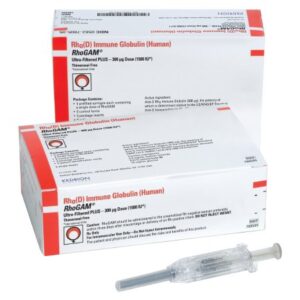Published: 22 February 2024

Rho(D) Immune Globulin (Rhogam) Overview
There are over 4,000 cases of Hemolytic Disease of the Newborn (HDN) in the United States every year, according to the Boston Childrens Hospital1. Luckily there are medical interventions in place which keep this number smaller than it would be otherwise. Rho(D) Immune Globulin, also known as Rhogam or RhIG, is a shot given to expectant mothers in order to prevent HDN. It is typically given at the 28-week mark as well as after delivery.
Although commonly referred to as “Rhogam”, this name is simply a brand name of one of several companies that produce RhIG. Therefore, the terms Rhogam and RhIG will be used interchangeably throughout this article, since Rhogam is the most common name that people are familiar with. Let us discuss the Rhogam shot in detail and how it can impact the pregnancy outcome of expectant mothers.
What Is Hemolytic Disease of The Newborn?
Hemolytic Disease of the Newborn, also known as HDN is a serious condition where an Rh-positive baby is attacked in the womb by the Anti-D antibodies produced by an Rh-negative mother. This can cause severe complications with the baby and even death.
HDN can also be caused by ABO incompatibility (Type O mother delivering to a type A, B or AB baby). This is due to the Anti-A and/or Anti-B antibodies in the mother’s blood mixing in with the fetal blood and binding with the A and B antigens on the fetal red blood cells. HDN due to ABO incompatibility is quite common, but is generally not life-threatening, unlike HDN due to Rh incompatibility.
Why Does Hemolytic Disease of The Newborn Happen?
The Rh factor is also known as the D antigen and is found on the surface of red blood cells of O positive, A positive, B positive and AB positive people. Those who are O negative, A negative, B negative and AB negative lack this D antigen and are considered Rh-negative.
When an Rh-negative mother delivers an Rh-positive baby, this is the circumstance which can trigger HDN. During delivery, the baby’s blood can get mixed in with the mother’s blood supply. The mother’s immune system detects the D antigen on the fetal RBCs and sees it as foreign, therefore producing maternal Anti-D antibodies. Even though the first baby is usually not affected, the mother is now “sensitized” and any subsequent Rh-positive babies will now be at risk for HDN due to the mother’s new production of Anti-D antibodies. During subsequent pregnancies, the maternal Anti-D will seek out Rh-positive fetal RBCs, bind to and destroy the cells, therefore harming the baby.
Something unique about Anti-D, is that since it is an IgG antibody, meaning it is small enough to cross the placental barrier and attack the baby, unlike the larger IgM antibodies like Anti-A and Anti-B.
Requirements for Rho(D) Immune Globulin Shot

The mere fact of being pregnant does not automatically qualify expectant mothers to receive the Rhogam shot.
The number one requirement is that the mother is Rh-negative. During pre-natal testing around the 28-week mark, doctors will order an RhIG workup, which consists of ABO/Rh, Antibody screen and RhIG determination.
Once the lab receives the specimen and runs the tests, they will result the ABO/Rh and Antibody screen. Then they will enter a result for the RhIG. If the mother was resulted as Rh-negative, then the tech will result that they are eligible for RhIG administration. Conversely, if their results come back as Rh-positive, the tech will instead result them as “Not Eligible” for the shot.
The reason that an Rh-positive mother is not eligible for Rhogam is because they already have the D antigen on their maternal RBCs. Even if they were to have an Rh-positive baby in the womb, their body wouldn’t produce Anti-D because those antibodies would attack the mother’s own cells as well as the baby’s. A rule in blood banking is that if you have an antigen on your RBCs, then you should not have the corresponding antibody in your plasma.
Because Rh-positive mothers do not produce Anti-D, their babies are at significantly less risk of HDN. It is for this reason, that Rh-positive mothers do not require Rhogam shots.
Once a Rh-negative mother delivers her baby, whether she receives an after-delivery dose still depends on the blood type of her baby. Immediately upon delivery, the baby’s cord blood is sent to the lab to be tested. The ABO group will be determined as well as the Rh-type and a Direct Antiglobulin Test (DAT). If the baby’s blood type comes back as Rh-positive, the mom will receive the post-delivery dose. If the baby comes back as Rh-negative, a post-delivery dose is not necessary. However, if a baby is initially typed as Rh-negative with routine methods, a procedure called “Weak-D” testing still needs to be performed to make sure they are not exhibiting a weak expression of the D antigen, since even this weak variant can be enough to trigger an immunogenic response in the mother. If the Weak-D test comes back as positive, then RhIG should still be given. If Weak-D comes back as negative, it can be disregarded.
Timing for Rhogam Shot/Dosage
The standard timeline for receiving Rhogam for Rh-negative mothers is at the 28-week mark as well as the 72-hour window after delivery.
At 28 weeks, 1 vial is normally given. This is standard because at this point in the pregnancy, the Rh status of the baby is still unknown. The baby’s Rh won’t be discovered until after delivery, when the cord blood will be collected and sent for testing. One dose of RhoGAM contains 300 µg (1500 IU) of Rho(D) Immune Globulin2.
After delivery, 1 vial is given again. Additional vials may be given if the mother has a positive “Fetal Screen” and a positive “Kleihauer-Betke” test. After delivery, mothers receive an additional test called a Fetal Screen as part of their post-delivery RhIG workup. This test detects if there was a placental bleed great enough for a significant amount of fetal RBCs to enter maternal blood circulation.

How Effective is the RhIG Shot?
Studies have shown that the use of RhIG after delivery decreases risk of Anti-D production from a baseline of 12-13%, down to 1-2%. This risk can be further decreased down to 0.1% by administrating RhIG in the antenatal period as well3.
Rhogam with Miscarriage & Abortion
If a mother’s pregnancy is terminated at 12 weeks gestation or prior, there is a smaller alternative dose available which is called the MICRhoGAM. MICRhoGAM is given within 72 hours of the termination and contains 50 µg (250 IU) of Rho(D) Immune Globulin. However, if the pregnancy is terminated after 12 weeks of gestation, the standard dose of 300 µg Rho(D) Immune Globulin should be given instead4.
Shot Location
Once the lab puts in the result to administer Rhogam along with the quantity of vials, the provider will send a nurse either to the blood bank or to the pharmacy to pick up the vial/s. Each hospital stores their Rhogam differently, but these are the most common places where it is stored. The Rhogam is then administered in either the upper arm, lateral thigh or buttocks.
How is Rhogam Made
Rhogam is made by collecting the plasma of Rh-negative donors who possess Anti-D. This is often done at the same plasma centers that most people are familiar with like Grifols, CSL and Lifeblood, but falls under a special Anti-D program.
Most of the procedures are the same as for standard plasma donors, except with the Anti-D program, donors must first undergo a series of vaccinations with Rh-positive red cells so that their body can induce an immune response and trigger the production of Anti-D. Once the concentration of the Anti-D is high enough in the bloodstream, donations may begin.
Once a donor has made it through onboarding, most centers will want a substantial commitment from the donor. For example, CSL’s program calls for donating twice per week, or at least 6 times per month, so prospective donors need to assess whether they will have enough time to devote to this over the long term5.
Rhogam Shortage
In early 2024, the FDA reported that a shortage of Rho(D) Immune Globulin has emerged nationwide in the United States due to “a reduction of supply due to increase in demand.” In a letter from Kedrion Biopharma Inc., a manufacturer of Rho(D) Immune Globulin, they stated that its supply is likely to “remain on allocation” for “the majority of 2024”6.
This is bad news for expecting mothers across the U.S. and means that we may be having a glimpse into what life was like before the discovery of RhIG, just decades ago. HDN may be a reality once again for many families. Due to the drastically reduced quantities available, medical teams will be forced to prioritize which mothers under their care will receive a dose. This might mean that even if they are prioritized high enough to receive a dose, they might not receive both the antenatal and postpartum doses, rather one or the other. Some hospitals were better prepared for this and had substantial stockpiles built up, while others were caught off guard and have next to zero boxes on the shelf to serve their patients with.
Potential solutions for this shortage might mean looking overseas and considering international suppliers. These suppliers are not going to be FDA-approved, so some manner of Emergency Use Authorization (EUA) may need to be initiated, similar to what was done with the COVID vaccine during the initial outbreak.
Conclusion

Rhogam has saved millions of baby’s lives while serving its role in preventing Hemolytic Disease of the Newborn in Rh-negative mothers over many decades. Looking forward, medical teams will need to devise ways to ease the critical shortages affecting the supply chain as well as developing suitable protocols for allocating doses according to clinical necessity.
References
1. Hemolytic Disease. (n.d.). Retrieved from Boston Children’s Hospital: https://www.childrenshospital.org/conditions/hemolytic-disease#:~:text=Hemolytic%20disease%20of%20the%20newborn%20(HDN)%20%E2%80%94%20also%20called%20erythroblastosis,approximately%204%2C000%20cases%20a%20year
2. Rho(D) Immune Globulin (Human). (n.d.). Retrieved from Rhogam Ultra-Filtered PLUS: https://www.rhogam.com/pdfs/RhoGAM%20Prescribing%20Information.pdf
3,4. Kerry J. Welsh, M. P., & Yu Bai, M. P. (2016, June 05). Pathology Consultation on Patients With a Large Rh Immune Globulin Dose Requirement. Retrieved from American Journal of Clinical Pathology: https://academic.oup.com/ajcp/article/145/6/744/2836667
5. Anti-D. (n.d.). Retrieved from CSL Plasma: https://www.cslplasma.com/anti-d
6. Regulatory Update: FDA Announces Shortages Of Rho(D) Immune Globulin. (2024, February 14). Retrieved from Association for the Advancement of Blood & Biotherapies: https://www.aabb.org/news-resources/news/article/2024/02/14/regulatory-update–fda-announces-shortages-of-rho(d)-immune-globulin











